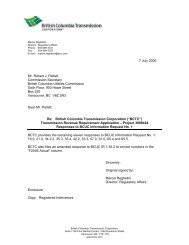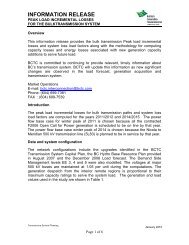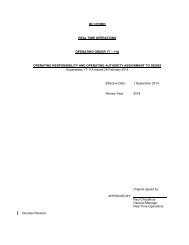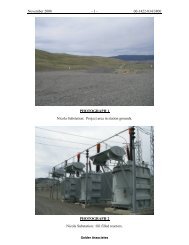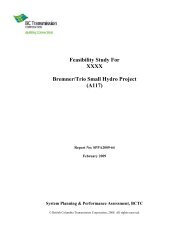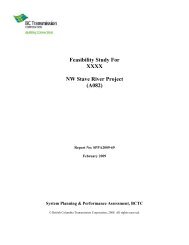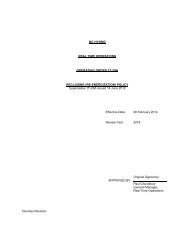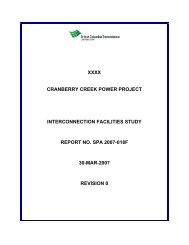Evidence on the Adequacy of First Nations Consultation - BC Hydro ...
Evidence on the Adequacy of First Nations Consultation - BC Hydro ...
Evidence on the Adequacy of First Nations Consultation - BC Hydro ...
You also want an ePaper? Increase the reach of your titles
YUMPU automatically turns print PDFs into web optimized ePapers that Google loves.
DRAFT REPORT: Rights and Title Interests in <strong>the</strong> Columbia Valley Transmissi<strong>on</strong> Project Area<br />
Salish neighbours were <strong>the</strong> Ktunaxa’s and Blackfeet’s sou<strong>the</strong>rn neighbours, <strong>the</strong> Fla<strong>the</strong>ad, 15<br />
whose name for <strong>the</strong>mselves is “séliš”, a term later anglicized as “Salish” and applied to an entire<br />
Language Family that includes <strong>the</strong> Shuswap. It is stated in <strong>the</strong> Handbook <strong>of</strong> North American<br />
Indians that <strong>the</strong> term “Salish” is not used in <strong>the</strong> Handbook to identify <strong>the</strong> Fla<strong>the</strong>ad people “to<br />
avoid c<strong>on</strong>fusi<strong>on</strong> with <strong>the</strong> widespread use <strong>of</strong> Salish for <strong>the</strong> whole Salishan family.” 16 Indeed, half<br />
<strong>the</strong> languages <strong>of</strong> <strong>the</strong> Plateau Culture Area bel<strong>on</strong>g to <strong>the</strong> Salishan Language Family. 17<br />
The Fla<strong>the</strong>ad people, as well as <strong>the</strong> Ktunaxa, had documented hostile relati<strong>on</strong>s with <strong>the</strong><br />
Blackfeet. 18 They are menti<strong>on</strong>ed in fur trader David Thomps<strong>on</strong>’s journal <strong>of</strong> 22 November 1800.<br />
Writing about a meeting with “Sac o tow wow, <strong>the</strong> Principal Chief <strong>of</strong> <strong>the</strong> Pekenows” [Peigans]<br />
who paid him a visit while camped <strong>on</strong> <strong>the</strong> Bow River, Thomps<strong>on</strong> reports that <strong>the</strong> Chief “spoke<br />
to us up<strong>on</strong> several Subjects—about <strong>the</strong> Kootanaes &c &c; he complained <strong>of</strong> our having armed<br />
<strong>the</strong>m by which means <strong>the</strong> Flat Heads would also acquire Arms to <strong>the</strong>ir great Hurt.” 19<br />
In 1798, two Ktunaxa in <strong>the</strong> company <strong>of</strong> <strong>the</strong> Piegans visited Edm<strong>on</strong>t<strong>on</strong> House 20 and advised <strong>the</strong><br />
traders <strong>of</strong> <strong>the</strong> quantity <strong>of</strong> furs available in <strong>the</strong>ir homeland. The House journal reports: “Beaver<br />
are said to be numerous in <strong>the</strong> Country <strong>of</strong> <strong>the</strong> Cotta na ha’s and nothing will prevent <strong>the</strong><br />
Canadians [North West Company] getting part <strong>of</strong> <strong>the</strong>m.” 21 The term “Cotta na ha” is clearly <strong>the</strong><br />
writer’s transcripti<strong>on</strong> <strong>of</strong> <strong>the</strong> term “Ktunaxa.” In that same year, 1798, according to historian and<br />
archaeologist David Chance’s review, <strong>the</strong> North West Company “made <strong>the</strong>ir move to get close to<br />
15 The term "Selish" (Salish) was originally applied by n<strong>on</strong>-Indian fur traders to <strong>the</strong> Fla<strong>the</strong>ad, a group <strong>of</strong><br />
people occupying <strong>the</strong> easternmost area <strong>of</strong> what is now Washingt<strong>on</strong> State. When early linguists discovered that <strong>the</strong><br />
language spoken by <strong>the</strong>se people was but <strong>on</strong>e <strong>of</strong> a large number <strong>of</strong> related languages, <strong>the</strong>y applied <strong>the</strong> name to <strong>the</strong><br />
whole family <strong>of</strong> languages. For additi<strong>on</strong>al comment <strong>on</strong> <strong>the</strong> hostile relati<strong>on</strong>s between <strong>the</strong> Peigans and <strong>the</strong> Fla<strong>the</strong>ad,<br />
see Barbara Belyea (1994). Columbia Journals: David Thomps<strong>on</strong>. McGill-Queens’s University Press: M<strong>on</strong>treal. She<br />
refers to <strong>the</strong> “Salish who lived al<strong>on</strong>e <strong>the</strong> Clark Fork and Kootenai rivers” (Belyea 1994, page 199).<br />
16 Carling Malouf (1998). Fla<strong>the</strong>ad and Pend d’Oreille. Handbook <strong>of</strong> North American Indians, Vol. 12,<br />
Plateau (ed. by Deward E. Walker Jr.). Smiths<strong>on</strong>ian Instituti<strong>on</strong>: Washingt<strong>on</strong> D.C. Page 312.<br />
17 Dale Kinkade, Bill Elmendorf, Bruce Rigsby and Haruo Aoki (1998). Languages. Handbook <strong>of</strong> North<br />
American Indians, Vol. 12, Plateau (ed. by Deward E. Walker Jr.). Smiths<strong>on</strong>ian Instituti<strong>on</strong>: Washingt<strong>on</strong> D.C. Page<br />
52.<br />
M<strong>on</strong>treal. P. 15.<br />
River.<br />
18 Malouf 1998, page 305.<br />
19 Barbara Belyea (1994). Columbia Journals: David Thomps<strong>on</strong>. McGill-Queens’s University Press:<br />
20 Also known as Fort Edm<strong>on</strong>t<strong>on</strong> and located where <strong>the</strong> Sturge<strong>on</strong> River meets <strong>the</strong> North Saskatchewan<br />
21 Chance 1981 (page 29) here menti<strong>on</strong>s <strong>the</strong> Edm<strong>on</strong>t<strong>on</strong> House journal, as cited in Hugh Dempsey (1973).<br />
History <strong>of</strong> Rocky Mountain House. Canada Historic Sites: Occasi<strong>on</strong>al Papers in Archaeology and History, No. 6.<br />
Ottawa. Page 11.<br />
Bouchard & Kennedy Research C<strong>on</strong>sultants Page 5<br />
Page 8 <strong>of</strong> 200






